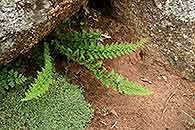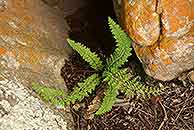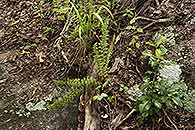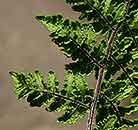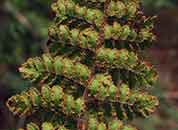Cheilanthes hirta Sw. [aggregate]
Synonyms |
Adiantum hirtum (Sw.) Poir. |
|---|---|
Common name |
Lip fern |
Description |
Rhizome short creeping or erect, up to 5 mm in diameter; rhizome scales awl-shaped, brown with dark central stripe and pale margins, margin entire, 3.5-9 mm long. Fronds monomorphic, tufted, erect, rigid, herbaceous to fairly coriaceous. Stipe 4-11 cm long, reddish to dark brown, up to 25 cm long, with reddish brown hairlike scales standing out stiffly from the stipe and with brown scales at the stipe base. Lamina 2-pinnate to 4-pinnatifid, lanceolate to linear-elliptic in outline, 8-60 cm × 2-15 cm; pinnae 15-26 pairs, oblong-lanceolate in outline, 0.8-10 x 0.6-2 cm; pinnules 7-15 pairs, triangular to oblong-ovate in outline, apex rounded, cut into rounded or slightly lobed segments, up to 8 x 4 mm, set with scattered, long, often gland-tipped hairs on both surfaces; veins free, indistinct; rhachis and secondary rhachises brown to reddish, set with reddish brown, sometimes gland-tipped, hairs. Sori small, discrete, on margins of slightly inrolled lobes; indusium minute (or absent), pale, membranous, entire to erose, ciliate. |
Notes | A lot of varieties have been described in the C. hirta complex. These are difficult to distinguish without a microscope. We therefore keep our information as broad as possible and refer to the cited literature for keys to the varieties. |
Derivation | hirta: hairy. |
Habitat | Rock crevices and at boulders, exposed or partially shaded, in woodland, rocky hills in wet grassland. |
Distribution worldwide | Africa, Madagascar, Mauritius, Réunion. |
Distribution in Africa |
Angola, Botswana, Ethiopia, Kenya, Lesotho, Mozambique, Namibia, South Africa, Swaziland, Tanzania , Uganda, Zimbabwe. |
Growth form |
Lithophytic, terrestrial. |
Literature |
|

